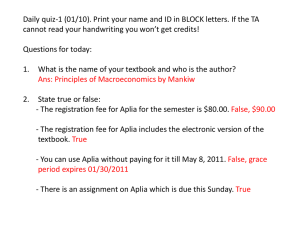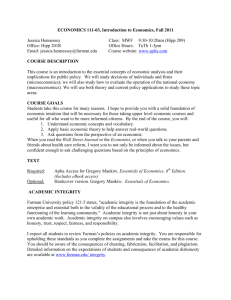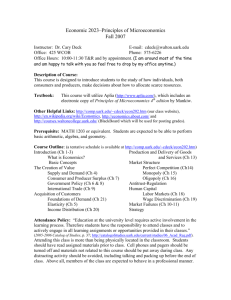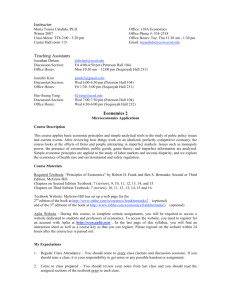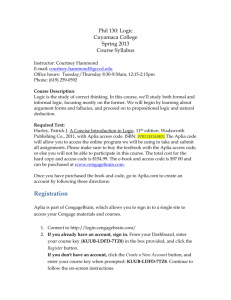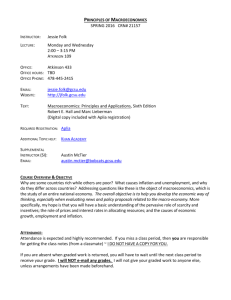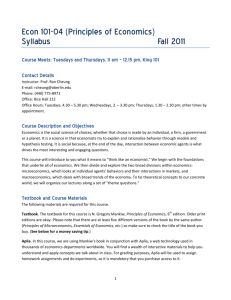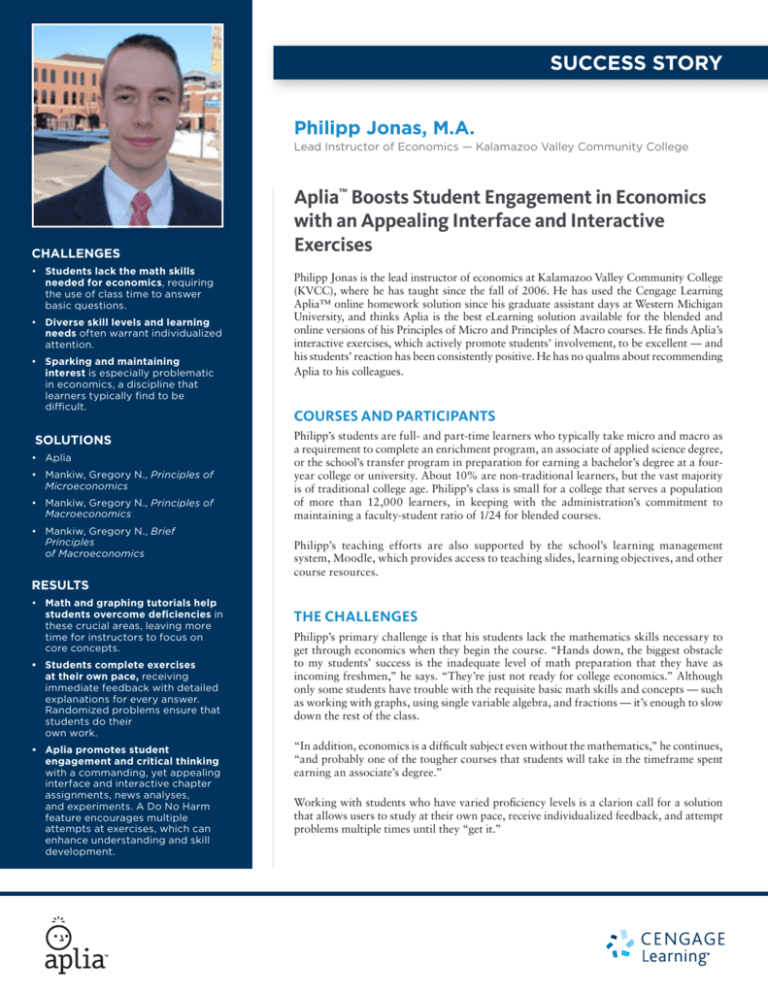
success story
Philipp Jonas, M.A.
Lead Instructor of Economics — Kalamazoo Valley Community College
Challenges
• Students lack the math skills
needed for economics, requiring
the use of class time to answer
basic questions. • Diverse skill levels and learning
needs often warrant individualized
attention.
• Sparking and maintaining
interest is especially problematic
in economics, a discipline that
learners typically find to be
difficult. Solutions
• Aplia
• Mankiw, Gregory N., Principles of
Microeconomics
• Mankiw, Gregory N., Principles of
Macroeconomics
• Mankiw, Gregory N., Brief
Principles
of Macroeconomics
results
• Math and graphing tutorials help
students overcome deficiencies in
these crucial areas, leaving more
time for instructors to focus on core concepts.
•Students complete exercises
at their own pace, receiving
immediate feedback with detailed
explanations for every answer.
Randomized problems ensure that
students do their own work.
•Aplia promotes student
engagement and critical thinking
with a commanding, yet appealing
interface and interactive chapter
assignments, news analyses,
and experiments. A Do No Harm
feature encourages multiple
attempts at exercises, which can
enhance understanding and skill
development.
Aplia™ Boosts Student Engagement in Economics
with an Appealing Interface and Interactive
Exercises
Philipp Jonas is the lead instructor of economics at Kalamazoo Valley Community College
(KVCC), where he has taught since the fall of 2006. He has used the Cengage Learning
Aplia™ online homework solution since his graduate assistant days at Western Michigan
University, and thinks Aplia is the best eLearning solution available for the blended and
online versions of his Principles of Micro and Principles of Macro courses. He finds Aplia’s
interactive exercises, which actively promote students’ involvement, to be excellent — and
his students’ reaction has been consistently positive. He has no qualms about recommending
Aplia to his colleagues.
Courses and Participants
Philipp’s students are full- and part-time learners who typically take micro and macro as
a requirement to complete an enrichment program, an associate of applied science degree,
or the school’s transfer program in preparation for earning a bachelor’s degree at a fouryear college or university. About 10% are non-traditional learners, but the vast majority
is of traditional college age. Philipp’s class is small for a college that serves a population
of more than 12,000 learners, in keeping with the administration’s commitment to
maintaining a faculty-student ratio of 1/24 for blended courses.
Philipp’s teaching efforts are also supported by the school’s learning management
system, Moodle, which provides access to teaching slides, learning objectives, and other
course resources.
The Challenges
Philipp’s primary challenge is that his students lack the mathematics skills necessary to
get through economics when they begin the course. “Hands down, the biggest obstacle
to my students’ success is the inadequate level of math preparation that they have as
incoming freshmen,” he says. “They’re just not ready for college economics.” Although
only some students have trouble with the requisite basic math skills and concepts — such
as working with graphs, using single variable algebra, and fractions — it’s enough to slow
down the rest of the class.
“In addition, economics is a difficult subject even without the mathematics,” he continues,
“and probably one of the tougher courses that students will take in the timeframe spent
earning an associate’s degree.”
Working with students who have varied proficiency levels is a clarion call for a solution
that allows users to study at their own pace, receive individualized feedback, and attempt
problems multiple times until they “get it.”
The Results
“Aplia’s questions
are well thought
out, not just on
a technical level,
but also on a
pedagogical level.
You can tell that
they were created
by someone who
has experience
teaching the
material and who
understands the
core mechanics of
what it takes to
learn economics.”
Philipp Jonas
Aplia allows Philipp to spend less class time teaching math, and more time teaching economics.
One reason is that the Aplia math and graphing tutorials help ill-prepared students get up to
speed with the rest of the class. When asked what he likes best about Aplia, Philipp cites the
interactive problem sets, which engage students in the course material and require them to think
about what they are learning.
“Aplia goes far beyond asking students to answer multiple-choice questions. For instance, its
graphing problems are as challenging and as effective as having students draw their own graphs,”
he says. “I also really like the ‘algo’ [algorithmic] questions. They aren’t provided as a fixed set of
questions that all students see. When a student tries an exercise again, Aplia generates a new set
of variables rather than drawing from a few different versions of it.” Scenarios, dates, quantities,
and names in Aplia exercises are randomized, ensuring that students do their own work —
and eliminating any temptation for them to share access with one another. Furthermore, while
each question has different versions, learning points are the same for every variation. Aplia also
incorporates articles from respected news sources, helping students connect current events with
course concepts.
“Aplia’s questions are well thought out, not just on a technical level, but also on a pedagogical
level,” says Philipp. “You can tell that they were created by someone who has experience teaching
the material, and who understands the core mechanics of what it takes to learn economics.”
Aplia’s Grade it Now feature allows students to receive immediate feedback on exercises, with
detailed explanations to guide them when they answer incorrectly. “The Do No Harm feature
incorporates a sensible grading mechanism that allows and even rewards students to make
multiple attempts at a problem, while holding them accountable for their work,” he says. “It
doesn’t simply record the highest grade among multiple attempts, so it eliminates the possibility
that a student will use an initial attempt just to see the explanation.” Students can work through
a problem several times if they wish, until they understand the underlying concept.
Students’ reactions to Aplia have been positive. Philipp credits the interface, which he says is
the best one among available homework solutions, with being critical to student engagement.
“Right from the start, my students show a respect for the platform that I don’t see with many
other platforms,” says Philipp. “Somehow, the interface communicates that Aplia is a serious and
authoritative college learning resource, and they approach it with a greater level of seriousness
as a result. When students take their work seriously, they’re more likely to succeed, so having
Aplia in the tool chest is an advantage.”
Kalamazoo Valley Community College
Lead Instructor of Economics,
Kalamazoo Valley
Community College
Kalamazoo, Michigan
To learn more about
this and other digital
solutions provided by
Cengage Learning, visit:
www.cengage.com/
DiscoverDigital
Source Code: 14L-AA0068
Cengage Learning is a leading provider of innovative teaching, learning, and research solutions
for academic, professional, and library markets worldwide. The company’s products and services
are designed to foster academic excellence and professional development, increase engagement,
improve learning outcomes, and deliver authoritative information to people whenever and wherever
they need it. Through the company’s unique position within both the library and academic markets,
Cengage Learning is providing integrated learning solutions that bridge from the library to the
classroom. www.cengage.com
Copyright ©2013 Cengage Learning. All Rights Reserved.

